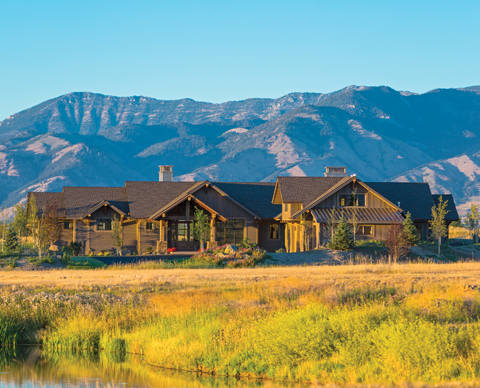Possibly the most basic element of a log or timber frame home project, as fundamental as the wood itself, is finding that perfect location. Whether on a mountainside, in the deep woods, or beside a tranquil lake, the land is its own design element in the overall appeal and presentation of a wood home.
Finding the right lot or acreage presents an opportunity to define the log home project in its entirety. In the right circumstances, the land and structure complement one another, existing in harmony and presenting the look and feel of a lifestyle to be envied and shared with others. The land, therefore, is an integral component of the package.
Often, the help of a real estate developer, relocation specialist, or sales agent is welcome in the discovery process. These professionals lend experience and insight into the course of events and assist in the initial steps toward log home ownership. Finding the right professional provides key advantages and makes the effort productive and enjoyable.
“My advice would be to talk to brokers in each office in your area of interest and ask them who specializes in land,” offers Sam Scoggin of Coldwell Banker Residential Brokerage in Reston, Virginia. “That’s how you find out who does the most business. Then, interview that agent and ask for a few references. I usually have lengthy discussions with the client so I can find out their wants and needs. Most people who are interested in log homes list land, space, and view as their top priorities in building a log home.”
Dave Kisko, sales associate with Yellowstone Club Realty in Big Sky, Montana, agrees. “Before prospective buyers meet with an agent or representative, they should create a list of priorities for a property in the order of most importance to them and convey it to the professional they wish to work with,” he explains. “This way, the party representing them is able to create a narrower focus to save the buyer time, and all involved can be more productive.”
Once that list of priorities is compiled, the search begins. “An agent will obviously search the local multiple listing service for land, but with area knowledge and a client base, they often know of land that is not listed on the market,” relates Gina Sakich, a top-producing broker/owner in the Chattanooga, Tennessee, area. “An aggressive agent may even contact land owners directly to see if they have any interest in selling. Another source for obtaining land is through auction companies. They very often have large parcels of land for sale.”
 Photo by Karl Neumann
Photo by Karl Neumann
While the agent, developer, and relocation specialist differ in their specific roles in the real estate market, the search for the right piece of land may be accomplished through any of these. The primary benefit for the client is knowledge of the specific market. According to Kisko, the type of professional is secondary as long as there is a solid foundation on which to build a relationship of trust and respect.
“Sitting down and talking is such an important part of the process,” says Kisco. “Whether that occurs in an office, coffee shop, on the phone, or on a drive to view properties doesn’t matter—only that the communication happens.”
During the process, the professional’s true value emerges. “Families that are looking for log or timber frame home properties tend to be looking in the same off the beaten path areas,” Kisko observes. “Subdivided property and boundaries, title review, covenants and architectural guidelines, water source, septic or drain field, access, along with many other items should be considered a large part of the property selection process. Don’t be blinded by the beauty of the property only to find out it is difficult to build on, you can’t get to it in bad weather, that you are not able to build what you want, water is not close by or is very deep, and other considerations.”
The devil is surely in the details, and the real estate professional helps the client navigate through a morass of regulation, restriction, and compliance concerns—not to mention the potential issues that are inherent with any piece of undeveloped real estate.
“When searching for the right piece of land, it is important to consider the size of the home to ensure that the lot size will accommodate it,” advises Sakich. “It is important to know if there are any drainage or flooding problems. If so, flood insurance may be required. Check for soil erosion and other soil problems with specific soil tests. It is also important to know if utilities are available along with sewer hookups. If utilities are available, where they are located, and how much it will cost to run the house?”
Scoggin warns prospective land purchasers to perform some due diligence on their own, becoming familiar with the land itself, community rules and responsibilities, remaining aware that the construction of a log or timber frame home is a specialized process—no two experiences are alike.
“I have been selling real estate for nearly 30 years, and during that time I have gained vast and valuable experience dealing with all types of clients,” Scoggin notes. “What I have learned is that it is crucial to listen to the client’s wants and needs. You must have great communication with your clients in order to have a successful outcome.”
The discerning client and the proven, reliable real estate professional share a common goal: the acquisition of the right piece of land. Each also appreciates the simple fact that the client may embark on a log or timber frame home project but once in their lives, while the real estate professional deals with such individuals and families on a daily basis. The mutually beneficial relationship results in clients beginning to realize their dream as the professional delivers the most positive of experiences.

